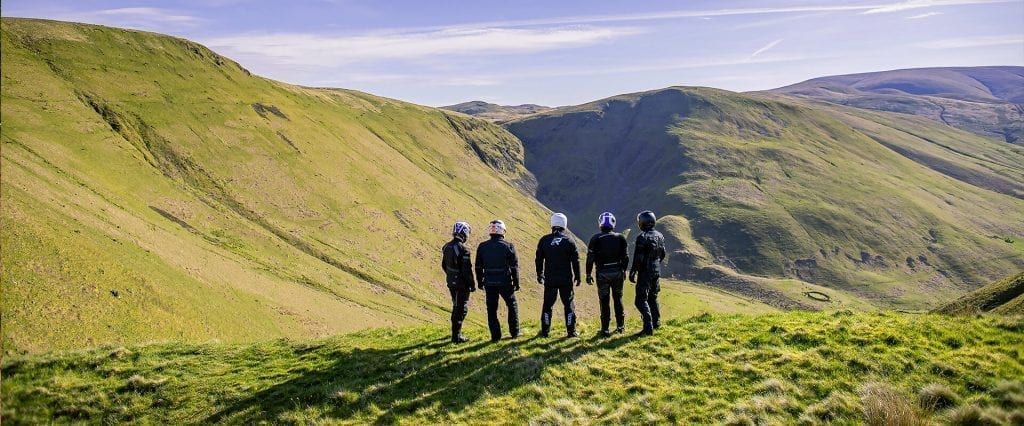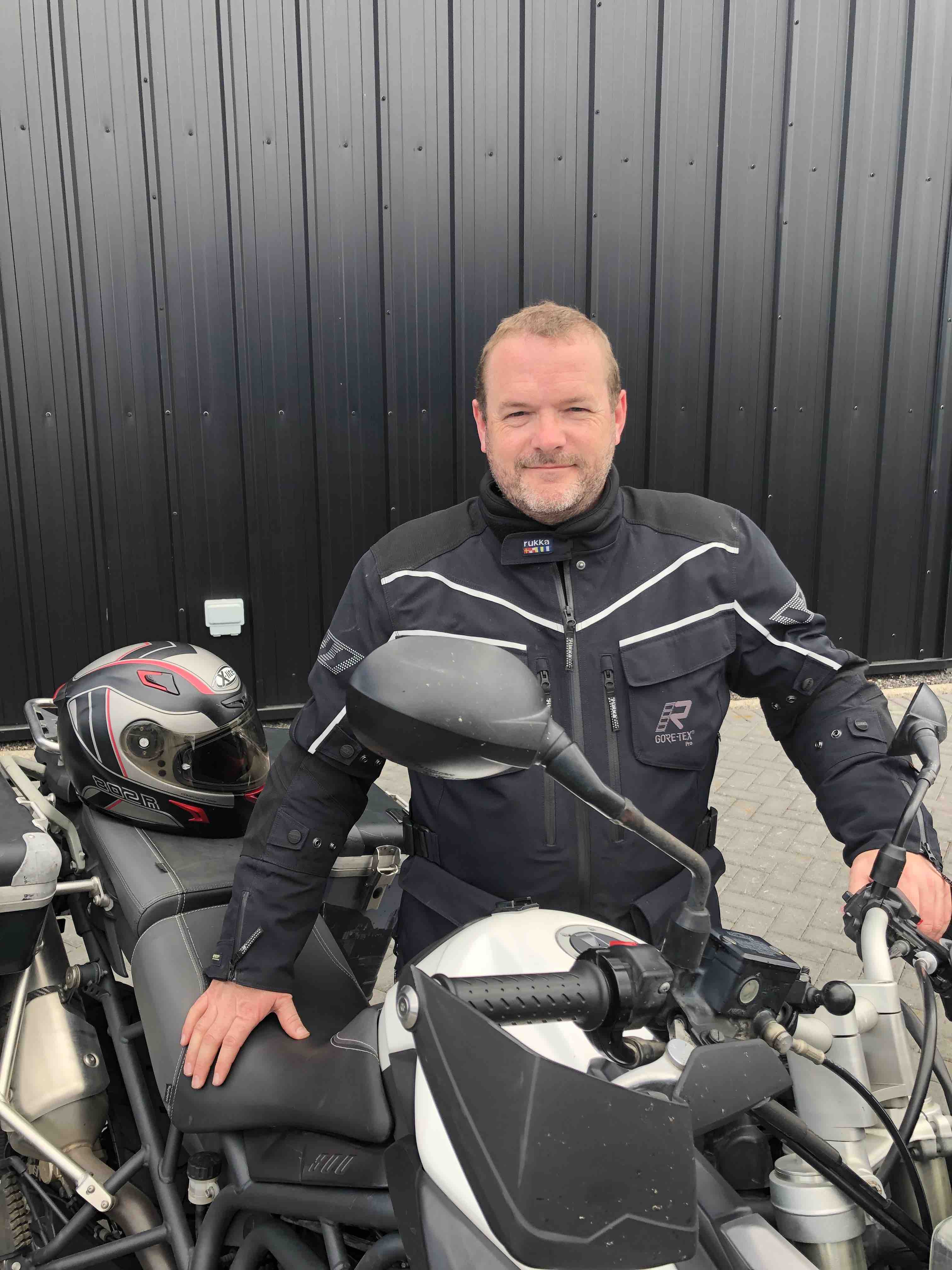Iliyas Campbell, road ambassador for The Devil's Beef Tub tells us why it’s one of his favourite Motorcycle routes in Scotland.
Why is the The Devil’s Beeftub an excellent Scottish motorcycle route to explore?
Most of my motorbiking touring around Scotland is further north, but the area around the Devil’s Beeftub gives me the opportunity to ride in a very different environment. The whole look of the Scottish Borders is different and that alone is refreshing.
I’m also a great fan of riding in the Isle of Man and although it may be a stretch – given speed limits here – the ride from Biggar to Moffat, particularly the road from Broughton into Moffat, is about the closest you can get to the roads and scenery of the Mountain Course on the Isle of Man. The Mountain Course has no speed limit – but just remember when you’re out biking, that the Broughton to Moffat road does!
Why is riding as part of a motorcycle group exciting?
Being able to experience and share the route with other like-minded riders brings a whole new aspect to motorcycling. Yes, there are times when you might want to get out alone and enjoy a bit of freedom and isolation, but being in a touring group brings with it the socialising and banter that only bikers will understand.
What safety measures do you have to consider when motorcycling with others in Scotland?
Riding as a group around Scotland’s routes is simplest when you ride as if you are on your own. What I mean by that is, follow the same rules of the road and take the same safety measures as you would if you were alone, but add into that the need to be aware of the rider in front and any rider behind you – in case they drop back.
You also need to remember that you don’t own the road, just because there’s a group of you riding. Other traffic may want to pass, so let them do so safely. We can all get a bit frustrated when being held up by other traffic and there are plenty of road warning signs cautioning against frustration. Don’t become a cause or a victim of road frustrations.
Before you set off, agree some stop-off locations along your motorbike route to regroup and make sure everyone is OK. You might stop at many other places for a break or to take in the views, but make sure you regularly check that everyone is still with you in case of motorbike breakdowns or other mishaps.
On a more individual level you should also do what some call the POWDERY checks on your bike before setting off for your first ride of the season.
- Petrol – Make sure you fill your tank and top up regularly. If your bike has been standing for a long period of time, old petrol can cause starting problems as it may clog up the fuel system. The best thing to do is drain your old petrol if there is a lot and fill up with new petrol.
- Oil – You can check you have the right amount of oil by using a dipstick or sight glass in the side of the engine casing. Remember to keep the bike vertical when checking this by getting someone to sit on the bike whilst you check the oil. Bear in mind that overfilling will also cause damage, so top up slowly and check your fuel level regularly.
- Water – This needs to be checked if you have a water-cooled engine. Again, the bike needs to be vertical. If you find that you’re low on water, remember never to use tap water as you’ll need a mix of water and antifreeze.
- Damage – Check for any damage – this could be on your bike, helmets or even your protective clothing.
- Electrics – If you’re taking your bike out for the first time in a while, it is always a good idea to check your lights and both the foot and hand brake light switches.
- Rubber – Remember to check your tyre pressure as well as the condition and tread depth. Bear in mind this could change depending on the amount of weight your bike is carrying. Remember to test this when your tyres are cold, as the reading will be higher when they’re hot. The legal limit is 1mm across three-quarters of the tyre and visible tread on the rest.
- You – If you’ve been out of practice for a few months, then you may have lost that ‘bike fitness’. Make sure you are fit to ride your bike and remember to take it slow and steady until you’ve got to grips with it.
Why is it important to be aware of the whole group on any motorcycle route, and not just yourself?
There can be a temptation for some riders to push their limits when in a touring group, but this should be avoided. The quickest way to get into trouble on the roads is to push beyond your abilities.
Other riders in the group also need to be aware of the skill levels and experience of the riders they are with. If it means stopping often to allow others to catch up, then you should – or consider having the slower / less experienced riders towards the front of the group.
Riders that regularly have to catch up with the group can feel a bit deflated and that’s not really the sort of experience we all want to have when riding.

Why is the Scottish Borders motorcycle route a favourite spot of yours to explore on two wheels?
The Borders can often be an overlooked destination for motorcycle routes in Scotland. It doesn’t have the rugged mountain landscape of the west coast and Highlands, but the rolling hills and scenery of the Borders are no less dramatic in their own way. The geography has given us some very nice open roads sweeping through the hills, twisty at times and technical in others when you get closer to villages and towns. There’s often a lot less traffic on these roads compared to the more popular routes further north.
What hotspots do you recommend stopping off at along The Devil’s Beeftub?
This is a motorcycle route with a lot to see: St Mary’s Loch, The Devil’s Beeftub and The Glen cafe are all popular stops in the area. If you have time it’s also worth taking a wander around Biggar, Moffat and Peebles.
What hazards on the road should you always be aware of?
Like most of the country, when you’re touring Scotland by motorbike, there are many farms in the area. These farms bring their own hazards. Farm machinery can drop mud and other substances on the road that can cause a lack of traction. There’s also the potential for animals such as deer, pheasant, sheep and the like to be roaming loose and of course farm livestock that are not always fenced in when you get into the more remote areas. Awareness is critical to riding around farms and rural areas.
Before setting out along the Borders route, what should you prepare for?
If you’ve ever ridden motorbikes in Scotland, you know to check the weather – we all know how quickly it can change so be sure you are ready for anything. Modern riding gear will usually cope with anything from warm to wet weather particularly if you are using leather or GORE-TEX clothing with zip vents for the warmer days.
Also, make sure you’ve charged your phone or camera. There’s a lot to see and it would be a shame not to capture some of it – not to mention the need for communication if you are in a remote area and need assistance.
Finally, why do you love riding your motorcycle in Scotland?
It’s true we may not have what some would consider the best of weather, but when the suns shines, Scotland is a stunning place to ride. When it rains the landscape has a rugged hard feel to it that sets a whole new scene – and with a bit of snow it can be absolutely breath-taking.
We also have incredible and varied scenery – from mountains and hills to bright white beaches and turquoise waters in the Hebrides – as well as great people, and an amazing depth of history.
Scotland has some of the most incredible riding routes to tour anywhere in the world. I’ve ridden numerous continents and since moving back to Scotland I can honestly say it is the best place for riding a motorbike. Get out there!
 The geography has given us some very nice open roads sweeping through the hills, twisty at times and technical in others when you get closer to villages and towns.
The geography has given us some very nice open roads sweeping through the hills, twisty at times and technical in others when you get closer to villages and towns.